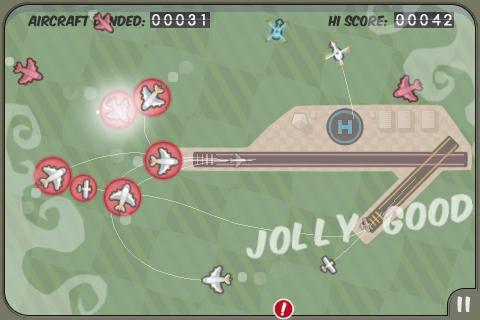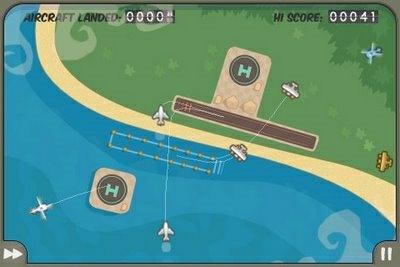- Wondering how to get Monopoly GO! free rolls? Well, you’ve come to the right place. In this guide, we provide you with a bunch of tips and tricks to get some free rolls for the hit new mobile game. We’ll …
Best Roblox Horror Games to Play Right Now – Updated Weekly
By Adele Wilson
Our Best Roblox Horror Games guide features the scariest and most creative experiences to play right now on the platform!The BEST Roblox Games of The Week – Games You Need To Play!
By Sho Roberts
Our feature shares our pick for the Best Roblox Games of the week! With our feature, we guarantee you'll find something new to play!Type Soul Clan Rarity Guide – All Legendary And Common Clans Listed!
By Nathan Ball
Wondering what your odds of rolling a particular Clan are? Wonder no more, with my handy Type Soul Clan Rarity guide.
Flight Control Review
The high-stress, high-responsibility life of an air traffic controller seems an unlikely inspiration for a light, distracting iPhone game. Yet that’s just what Flight Control provides: a hectic, fast-paced distraction that flies that fine line between chaos and control to a safe landing on a very addictive runway.

The high-stress, high-responsibility life of an air traffic controller seems an unlikely inspiration for a light, distracting iPhone game. Yet that’s just what Flight Control provides: a hectic, fast-paced distraction that flies that fine line between chaos and control to a safe landing on a very addictive runway.
Things start off calmly enough, with a single red jet flying in a slow, straight line from the edge of the screen. Simply tap it and drag a new path to the matching red runway, then watch as it slowly glides to a safe landing and out of play. Simple enough. Then a yellow biplane and blue helicopter show up, lazily drifting along on a collision course that would end the game. Don’t panic — just guide them out of each others’ way and towards their own color-coded landing areas. So far it’s a colorful, non-threatening way to pass the time.

But then the aircraft start streaming in more quickly. First five, then ten, the dozens of planes clutter the screen at a time, each with their own spindly white lines dangerously intersecting other planned flight paths. Soon you’re frantically and desperately flicking a helicopter out of the way of an incoming bi-plane, then darting your eyes and your thumb over to divert a speedy red mega-liner into an impromptu holding pattern so a slower jet can use the runway. And then it’s on to the next crisis, and the next, coming almost too fast for you to react, until, eventually, you’re distracted for a split-second too long and two aircraft end the game with a loud collision. Despite the disaster, you’re likely itching to play again.
Flight Control‘s detailed interface makes it easy to keep track of all this insanity with a quick glance. The responsive multi-touch controls let you guide multiple planes at once, and the game uses little cues — a satisfying “click” sound, a small halo effect around the runway — to let you know when you’ve made a successful path. A short warning siren and large red circles around the planes let you know about imminent collisions — hopefully drawing your attention just before it’s too late — and large exclamation point signs warn you when a plane is about to sneak in from the side, so there are no surprises.
There’s a handy pause button to stop games when the real world interferes, and an even handier fast-forward button that allows expert players to speed up those slow first few minutes of each new game. The only major problem with the interface is that the game sometimes has trouble telling which plane you’re selecting when two aircraft are getting close to a collision.

It’s a good thing the core gameplay is so addictive, because the game is pretty light on extras. There are four different airport arrangements to play, each with slightly different runway patterns, but playing one is much like playing any other. The most interesting by far is an Australia-themed airport with priority medical planes that can’t be re-routed. An online high score list provides frequent new targets to shoot for, and even lets you compare your scores to players who are nearby in the real world. The game also keeps track of a few peronal stats, including a running total of how many total aircraft you’ve landed during your career, a good way to gauge just how much time you’ve wasted playing this game.
And trust me, it’ll be a lot of time. Even though every game of Flight Control ends with a failure, it almost always feels like a failure you could have prevented if you had been just a little faster or more attentive. It’s this feeling that will drive you into a string of “one more game” attempt to beat that high score for a long time to come.

The good

The bad
More articles...
Monopoly GO! Free Rolls – Links For Free Dice
By Glen Fox
Wondering how to get Monopoly GO! free rolls? Well, you’ve come to the right place. In this guide, we provide you with a bunch of tips and tricks to get some free rolls for the hit new mobile game. We’ll …Best Roblox Horror Games to Play Right Now – Updated Weekly
By Adele Wilson
Our Best Roblox Horror Games guide features the scariest and most creative experiences to play right now on the platform!The BEST Roblox Games of The Week – Games You Need To Play!
By Sho Roberts
Our feature shares our pick for the Best Roblox Games of the week! With our feature, we guarantee you'll find something new to play!Type Soul Clan Rarity Guide – All Legendary And Common Clans Listed!
By Nathan Ball
Wondering what your odds of rolling a particular Clan are? Wonder no more, with my handy Type Soul Clan Rarity guide.







